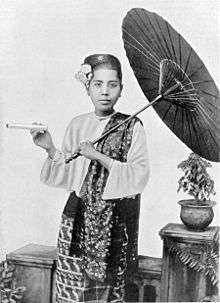Women in Myanmar
 A Burmese woman in traditional garb, c. 1920. | |
| Gender Inequality Index | |
|---|---|
| Value | 0.437 (2012) |
| Rank | 80th |
| Maternal mortality (per 100,000) | 200 (2010) |
| Women in parliament | 4.0% (2012) |
| Females over 25 with secondary education | 18.0% (2010) |
| Women in labour force | 75.0% (2011) |
| Global Gender Gap Index | |
| Value | NR (2012) |
| Rank | NR out of 144 |
Historically, women in Myanmar (also known as Burma) have had a unique social status in Burmese society. According to the research done by Daw Mya Sein, Burmese women "for centuries – even before recorded history" owned a "high measure of independence" and had retained their "legal and economic rights" despite the influences of Buddhism and Hinduism. Burma once had a matriarchal system that includes the exclusive right to inherit oil wells and the right to inherit the position as village head. Burmese women were also appointed to high offices by Burmese kings, can become chieftainesses and queens.[1]
Traditional dress
The htamein (ထမီ [tʰəmèɪɴ]) is one of the traditional dresses of Burmese women.[1][2] This skirtcloth or lower body wrapper was worn by women during the Konbaung Dynasty (1752–1855) as a wrap-around skirt, or sometimes as a folded clothing material placed "tightly across the abdomen slightly left center of the waist".[2] In comparison, Burmese men wore the traditional lower garment known as the pahso (ပုဆိုး [pəsʰó]).[2]
Love and marriage
Marriages were previously allowed between Burmese women and male foreigners provided that the divisional courts in Burma were informed within 21 days of advance notice. However, in May 2010, the government of Burma disallowed conducting of marriage ceremonies between Burmese women and male foreigners.[3] One of the suggested reasons was to avoid human trafficking.[3] Burmese women become victims of human traffickers and traded for the sex industry in Pakistan and Thailand.[4]
To some extent, arranged marriages was also a part of Burmese tradition, however, the Burmese women have the right to refuse the offer of being betrothed to the parents' chosen partner for her. At present, young Burmese women can choose to marry someone for love.[3]
Women's rights
In 2000, the Asian Women's Resource Exchange (AWORC) published a report entitled Human Rights in Burma from the Forum News (August 1998) describing that by tradition, Burmese women are maternal self-abnegators, meaning that these women "consistently forgo their own needs in order to give their children first priority." The report also indicated that rural and urban Burmese women were affected by the deteriorating economic climate in Burma. As a result, Burmese families were "increasingly prioritising the rights of males over females to limited resources." These changes affected the access of Burmese women to nutrition, medical services, vocational training, and other educational opportunities. Burmese women became unwilling porters and unpaid labourers for the military, including becoming victims of slavery, murder, torture, rape, and attacks.[5] Historically, urban Burmese women "enjoyed high levels of social power" but later became confronted with restrictions on speech and limitations in acquiring high level positions in both private and public offices.[5] According to AWORC, only a few number of Burmese women receive education related to reproductive rights and safe birth control practices, thus making them prone to being infected by HIV and AIDS.[5]
In January 2008, BBC News featured Burmese Kayan Lahwi women who became tourist attractions in Thailand because of the tradition of wearing coils of brass around their necks. The rings of brass push the "women's shoulders and ribs down" throughout several years giving the effect as if the necks had been stretched, thus described as sporting "unnaturally long, giraffe-like necks."[6]
See also
- Aung San Suu Kyi
- Supayalat, last queen of Burma
- Women's League of Burma
- Myanmar Women's Affairs Federation
- Women's Auxiliary Service (Burma)
- Myanmar women's national football team
- Shan Women's Action Network
References
- 1 2 Daw Mya Sein. "Women in Burma", The Atlantic, Atlantic Magazine, February 1958.
- 1 2 3 Falconer, John and Luca Invernizzi Tettoni. Burmese Design and Architecture, Tuttle Publishing, page 189.
- 1 2 3 Thae Thae. Burmese Women Not Allowed to Marry Foreigners, The Irrawaddy, 25 May 2010.
- ↑ Trafficking, Burma/Myanmar, Factbook on Global Sexual Exploitation, Coalition Against Trafficking in Women
- 1 2 3 Human Rights in Burma, Asian Women's Resource Exchange (AWORC), 2000
- ↑ Harding, Andrew. Burmese women in Thai 'human zoo', 30 January 2008.
External links
| Wikimedia Commons has media related to Women of Myanmar. |
| Wikimedia Commons has media related to People of Myanmar. |
- Women's League of Burma
- Karen Women Organization
- Burmese women in Thai 'human zoo'
- The war on Burma's women

.jpg)